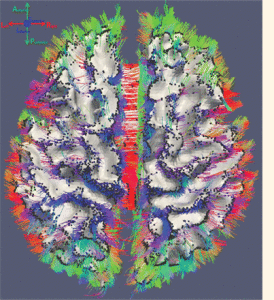Distinguishing self and other in joint action. Evidence from a musical paradigm.
 The capacity to distinguish between one’s own and others’ behavior is a cognitive prerequisite for successful joint action. We employed a musical joint action task to investigate how the brain achieves this distinction. Pianists performed the right-hand part of piano pieces, previously learned bimanually, while the complementary left-hand part either was not executed or was (believed to be) played by a co-performer. This experimental setting served to induce a co-representation of the left-hand part reflecting either the self or the co-performer. Single-pulse transcranial magnetic stimulation was applied to the right primary motor cortex and motor-evoked potentials (MEPs) were recorded from the resting left forearm. Results show that corticospinal excitability was modulated by whether the representation of the left hand was associated with the self or the other, with the MEP amplitude being low and high, respectively. This result remained unchanged in a separate session where participants could neither see nor hear the other but still infer his presence by means of contextual information. Furthermore, the amplitude of MEPs associated with co-performer presence increased with pianists’ self-reported empathy. Thus, the sociality of the context modulates action attribution at the level of the motor control system.
The capacity to distinguish between one’s own and others’ behavior is a cognitive prerequisite for successful joint action. We employed a musical joint action task to investigate how the brain achieves this distinction. Pianists performed the right-hand part of piano pieces, previously learned bimanually, while the complementary left-hand part either was not executed or was (believed to be) played by a co-performer. This experimental setting served to induce a co-representation of the left-hand part reflecting either the self or the co-performer. Single-pulse transcranial magnetic stimulation was applied to the right primary motor cortex and motor-evoked potentials (MEPs) were recorded from the resting left forearm. Results show that corticospinal excitability was modulated by whether the representation of the left hand was associated with the self or the other, with the MEP amplitude being low and high, respectively. This result remained unchanged in a separate session where participants could neither see nor hear the other but still infer his presence by means of contextual information. Furthermore, the amplitude of MEPs associated with co-performer presence increased with pianists’ self-reported empathy. Thus, the sociality of the context modulates action attribution at the level of the motor control system.
Download articolo completo:


